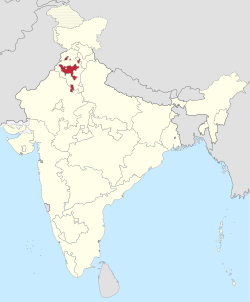Top Qs
Timeline
Chat
Perspective
Patiala and East Punjab States Union
Former State of India From Wikipedia, the free encyclopedia
Remove ads
The Patiala and East Punjab States Union (PEPSU) was a State of India, uniting eight princely states between 1948 and 1956. The capital and principal city was Patiala. The state covered an area of 26,208 km2. Kasauli, Kandaghat and Chail was also part of PEPSU.
Remove ads
History
Summarize
Perspective
Princely states union
It was created by combining eight princely states (7 Punjab States & 1 Punjab Hill State), which maintained their native rulers :
- Six Salute states
- Patiala, title Maharaja, Hereditary salute of 17 guns (19-guns local)
- Jind, title Maharaja, Hereditary salute of 13 guns (15-guns personal and local)
- Kapurthala, title Maharaja, Hereditary salute of 13 guns (15-guns personal and local)
- Nabha, title Maharaja, Hereditary salute of 13 guns (15-guns local):
- Faridkot, title Raja, Hereditary salutes of 11 guns
- Malerkotla, title Nawab, Hereditary salute of 11 guns
- and two Non-salute states
- Kalsia, title Raja (till 1916 Sardar)[citation needed]
- Nalagarh, title Raja.
The state was inaugurated on 15 July 1948 and formally became a state of India in 1950.
Successor states

On 1 November 1956, PEPSU was merged mostly into Punjab State under the States Reorganisation Act.[1]
A part of the former state of PEPSU, including the present day Jind district (Jind & Narwana), area of Pinjore in north Haryana, as well as the Charkhi Dadri, Bawal and Mahendragarh Narnaul in south-west Haryana, presently lie within the state of Haryana, which was separated from Punjab on 1 November 1966. Some other areas that belonged to PEPSU, notably (Kandaghat etc.) Solan and Nalagarh, now lie in the state of Himachal Pradesh.
Remove ads
Rajpramukh and Uparajpramukh
Chief Ministers
Summarize
Perspective
Color key
Other keys
- Acting Chief Minister
Institutions
Summarize
Perspective

Heads of state and government
When the state was formed, the then-Maharaja of Patiala, Yadavindra Singh, was appointed its Rajpramukh (equivalent to Governor). He remained in office during the entire length of the state's short existence. The then Maharaja of Kapurthala, Jagatjit Singh, served as Uparajpramukh (lieutenant-governor).[citation needed]
Gian Singh Rarewala was sworn in on 13 January 1949 as the first Chief Minister of PEPSU. Col. Raghbir Singh became the next Chief Minister on 23 May 1951, and Brish Bhan the Deputy Chief Minister.[3]
The state elected a 60-member state legislative assembly on 6 January 1952. The Congress Party won 26 seats and the Akali Dal won 19 seats.
On 22 April 1952, Gian Singh Rarewala again became Chief Minister, this time an elected one. He led a coalition government, called the "United Front", formed by the Akali Dal and various independents. On 5 March 1953 his government was dismissed and President's rule was imposed on the state.[4] In the mid-term poll that followed, the Congress party secured a majority and Raghbir Singh became Chief Minister on 8 March 1954. Upon his death, Brish Bhan became the Chief Minister on 12 January 1955 and remained in office as last incumbent.[citation needed]
Remove ads
Administration
Summarize
Perspective
Initially, in 1948, the state was divided into the following 8 districts & 25 sub-districts (tehsils):[5]
- Patiala - Patiala, Nabha, Rajpura
- Kapurthala - Kapurthala, Phagwara
- Bathinda - Bathinda, Mansa, Faridkot
- Fatehgarh Sahib - Sirhand, Payal, Amloh
- Barnala - Barnala, Phul, Dhuri, Malerkotla
- Sangrur - Sangrur, Sunam, Narwana, Jind
- Kohistan - Kandaghat, Nalagarth, Dera Bassi
- Mohindergarh - Mohindergarh, Narnaul, Dadri
In 1953, the number of districts in PEPSU was reduced from eight to five. Fatehgarh Sahib and Kohistan districts were dissolved and merged with Patiala district. Amloh and Payal tehsils of Fatehgarh Sahib were merged with Sirhind tehsil, while Dera Bassi tehsil of Kohistan district was merged with Rajpura tehsil. Barnala district was also abolished. It had four tehsils: Phul, Dhuri, Malerkotla, and Barnala. Dhuri, Malerkotla, Barnala, and part of Phul tehsil were transferred to Sangrur district, while the remaining portion of Phul tehsil was merged with Bhatinda district.[6][7]
There were four Lok Sabha constituencies in this state. Three of them were single-seat constituency: Mohindergarh, Sangrur and Patiala. The Kapurthala-Bhatinda Lok Sabha constituency was a double-seat constituency.
Remove ads
Demography
The state had a population of 3,493,685 (1951 census), of which 19% was urban. The population density was 133/km2.[8] The state had 64 towns and 5,708 villages.[5]
Notes
- President's rule may be imposed when the "government in a state is not able to function as per the Constitution", which often happens because no party or coalition has a majority in the assembly. When President's rule is in force in a state, its council of ministers stands dissolved. The office of chief minister thus lies vacant, and the administration is taken over by the governor, who functions on behalf of the central government. At times, the legislative assembly also stands dissolved.[2]
Remove ads
References
Further reading
Wikiwand - on
Seamless Wikipedia browsing. On steroids.
Remove ads








